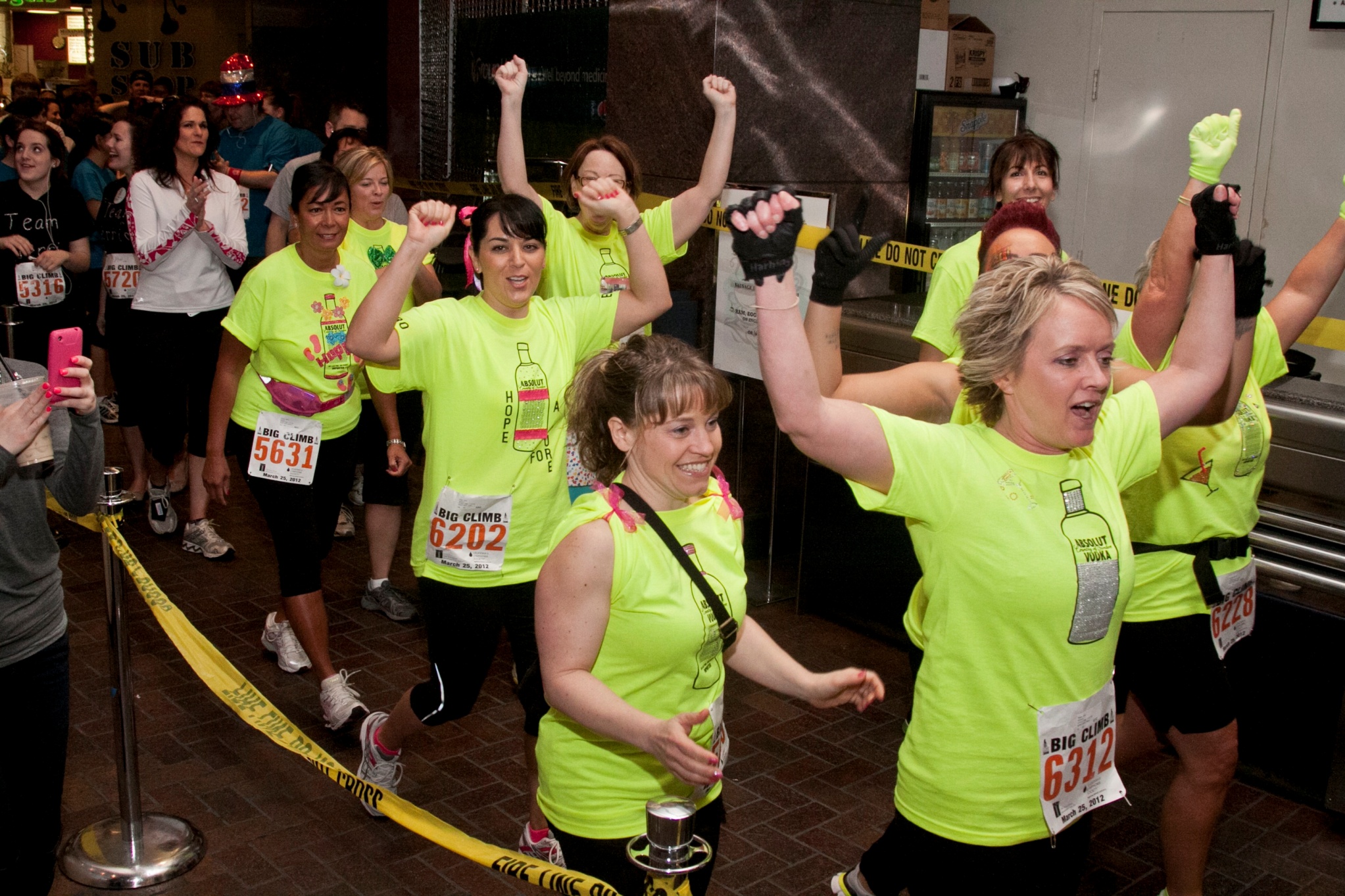Mission
Meet A Few of Our Inspirational Big Climb Survivors and Find Out Why They Climb!
Stories written by Emily Muirhead
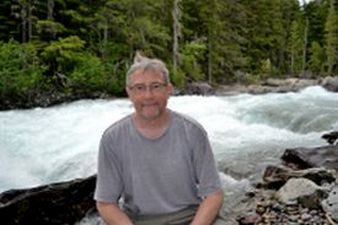
Andrew Taylor - To The Top
Team captain of the Big Climb team To the Top, Andrew Taylor, had recently become a father for the first time back in 2007. When his child was only two weeks old, a house fire burned through his home. While his family remained safe, there was some structural and smoke damage from the fire that needed repair.
Taylor took it upon himself to lay down some layers of shellac to conceal some of the damage. Almost exactly six months later, Taylor noticed an unusual mass in his abdomen, and doctors soon diagnosed him with non-Hodgkin’s lymphoma. He was told the tumor appeared to have been growing for approximately six months – almost exactly since the time he had unintentionally inhaled some chemical fumes from making the repairs on his home.
After this, his family relocated to a different home to start over and he began treatment with rounds of chemotherapy. He underwent six rounds of chemo, which his body reacted well to, although he did lose his hair during the process.
Unfortunately, but not necessarily uncommonly, his lymphoma came back two and a half years later. Taylor once again self-identified that he had at tumor growing, but this time it was found near his throat. By this time his cancer had reached stage 4, and he underwent a stem cell transplant using his own stem cells. This time around the treatment was undeniably tough on Taylor, and meant he had to take time off work from his job at Microfocus.
The stem cell transplant produced only temporary results before just one more year passed and the cancer made its comeback again. Doctors told Taylor he’d need a second stem cell transplant but that it had to come from someone else’s cells, and it needed to be a very specific match.
This type of transplant is inherently risky. Because foreign cells are being placed in a patient’s already susceptible body, the risk of rejection is high if proper procedures and precautions are not taken very seriously.
Because Taylor has an “odd marker” in his genes, he was unable to find a person who was a match in the donor pool to do the transplant. His sister offered to be the donor, and Taylor eventually accepted when no other alternatives could be found.
Getting to the point to be ready for the transplant is a strenuous road. He had to endure more chemo, full-body radiation, and take even more time off of work. He experienced some rough side effects that caused loss of most of his ability to taste, significant weight loss, and at one point he became so thin he had to be put on a feeding tube. His fingers would go numb, extreme cramping at night caused lack of sleep, and there was of course the persistent nausea that seemed like it would never go away.
But all in all, the transplant was a success and Taylor has now passed his 5-year remission mark in May of 2017.
“This procedure was fairly new and risky even 20 years ago, so there have been a lot of advances over the last 10-15 years and a lot of that is due to funding from LLS,” Taylor said. “If this hadn’t work I probably wouldn’t be here. But it did, and my sister is my hero.”
He says many people have asked him what he’s going to do to celebrate his 5-year mark. To this he has to say, take care of his responsibilities. While the cost of treatment didn’t absolutely break the bank for Taylor, and as much as he wishes he could take off and travel, taking a break from his regular life post-cancer is no simple task.
“In reality I don’t have the money to go to Hawaii or on some big trip,” Taylor said. “I have my two kids to take care of, and it’s expensive and time consuming and not everyone has the ability to change up their life. If anything, they would have more bills to keep up with. I probably spent $10K every time I got sick on just copays and the basics,” Taylor said.
It’s obvious that most of Taylor’s focus surrounds being a dedicated father. When he talks about taking his two children on trips to camp in the woods, or plans to visit Banff National Park in Alberta his eyes light up. He says that every year he’s thinking about how he can help create memories and make a great trip for his kids. If remission means anything, it must mean the ability to spend more time with those who matter most.
He is confident that his cancer won’t return, and that he is in the clear for the long haul. He no longer goes in for regular checkups, and brings up the point that in all honesty it’s a serious financial burden. On average, one appointment with scans might cost $1,000 and require taking a vacation day “to get poked, prodded, and told that he’s ok.”
“Everything SCCA has done for me is amazing,” Taylor says. “But I want to leave this behind me. I don’t have fear anymore and I’m done.”
He knows that he would be wasting his time worrying about the ‘what if’s’, and is an advocate of living a balanced life and a committed parent. For him it’s all about living life cancer-free in every sense of the phrase, and doing what he can to give back to the community that supported him throughout his battle.
In fact, last year’s Big Climb was the first event where both his children joined him in the stairwell. They each had their own fundraising pages, and wrote their own reasons for why they were climbing and fundraising for a cure. For Taylor it’s important to educate his children and be transparent about his experiences and how they can do their own part in helping find a cure for blood cancers.
Education about the world of blood cancer is important to Taylor. He even has participated in a couple video projects put on by the National Health Institute about his personal treatment experience, and how he navigated his experience.
He’s satisfied knowing that he can contribute to what those going through a new cancer diagnosis can learn to expect, and hear from varying perspectives. Being your own advocate is also a major piece of how Taylor handled his run with cancer.
At first, his oncologist wasn’t a great fit for what Taylor needed. He was looking for hard facts and realistic, in-depth information that he felt he wasn’t getting. After switching to a different oncologist, Taylor felt it was a better match and that the two would find better success.
“Learning how to step up and advocate for myself really turned into a good thing,” Taylor said. “In general I don’t really have much advice to give about this because I think that people should simply do what is right for them.”
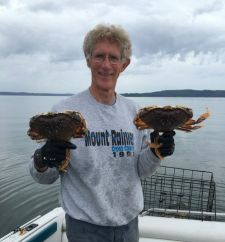
Colin Craig - Craig's Legs
Colin Craig is an infectiously positive person. Whether it be his jolly voice, shock of curly white hair, or the literal bounce in his step, he is sure to put a smile on the face of anyone he crosses paths with. One might think that his life has always been smooth sailing, but that is not the case.
Soon after he took up road biking in 2009, his passion for cycling took off. In 2010 he was inspired to join the Leukemia & Lymphoma Society's Team in Training program to complete "America's Most Beautiful Bike Ride", a century (100-mile) bike ride around Lake Tahoe. It was only three years later in an ironic twist that he was stricken with a blood cancer, the very disease he had been fundraising and cycling to rally against.
At the age of 64 Craig was diagnosed with stage 3 follicular lymphoma, a form of non-Hodgkin's lymphoma in February of 2013.
Luckily, Craig's symptoms weren't too severe. They began as occasional abdominal pain and exhaustion that seemed to be unfounded. Because of this, in January 2013 he made a visit to the doctor who confirmed he had an extremely enlarged spleen and a blood count that deviated from the norm. After being referred to a secondary doctor for a PET scan, Craig walked into the office and discovered it was a cancer care unit he was visiting, and had his first rude awakening of what his symptoms could mean. The PET scan revealed nodes all over his body and a cancer diagnosis was confirmed. Soon after he was placed in a phase 3 clinical trial for his specific type of lymphoma.
Craig was fortunate enough to be randomly selected to receive the trail arm of the clinical trial, meaning he was set to receive the full regimen of drugs. It was decided that he would take on a two drug trial combination instead of R-CHOP chemotherapy, an acronym for five different drugs given in phases three weeks at a time, up to eight cycles, and typically over the span of 3-4 months. Side effects for Craig were very minimal and he is well aware that this is definitely not always the norm.
"If I didn't tell people I was being treated for cancer, they probably would've never known," Craig said. "Because I had a targeted therapy drug that wasn't 'systemic', it targeted certain proteins on lymphocytes so that in turn, it lets my immune system recognize what it was supposed to, and didn't harshly affect other parts of my body."
He admits that whenever he speaks with other patients who have gone through intensely trying and painful treatments, side effects, and recoveries, he feels guilty. He was lucky enough to be one of he few that tolerated his chemotherapy very well, and hopes that through advancements in less toxic treatments and cures, someday this will be the case for all those who are diagnosed.
Currently, Craig goes in every six months for blood tests and an annual CAT scan and is set to be monitored in this capacity for a total of 10 years to fulfill his participation in the trial.
As a career dentist for the past 43 years, Craig understands the medical world and therefore he enjoyed the opportunity to take part in a clinical trial. He knows how fortunate he is to be in a position where he is held accountable for regular check-ups so that if something ever were to come back, doctors would theoretically be able to catch it very early on.
"I never felt like I was going to be defeated by [my cancer]," Craig said. "It was just going to be a hiccup in my life and that it would be ok. My dad died of lung cancer and my sister died of pancreatic cancer, so it's not like [my family] has been immune to it in our lives, but my mindset was like 'this isn't how things are going to end, so let's just get on with it and get it done.'"
His cheerful perspective and intention to handle his illness as more of a manageable affliction rather than a potentially deadly disease has helped him to push past the negativity. His wife even tells him he's now more of an extrovert who is always eager to engage with people and hear about their lives. For Craig, learning to better take advantage of his days and the connections he makes with others is a pleasant byproduct of his diagnosis. He makes a point to never dwell on tomorrow, and always make good use of today.
Craig keeps fundraising because he knows funding research and patient services is the only thing that will help current and future patients so that they hopefully can also have a smooth outcome like his.
But that's not to say his experience was always simple. It came with challenges and emotional hurdles indeed. His wife, Leah, and two sons were instrumental in supporting Craig through his experience, and he says the staff of his dental practice were a wonderful support system too.
Back in 2013, members of his dental staff decided to volunteer at Big Climb in his honor, and in 2014 Craig's Legs was born. Since then his team has raised an impressive $200,00 with the help of friends, family (including most of his grandkids), staff and patients. The first year Craig was able to climb he was selected as an official event honoree and has become a big advocate of the work done by the Leukemia & Lymphoma Society and wants to continue recruiting people to join.
"I'm always introducing our team to new people who are going through their own cancer struggles," Craig said. "We have this one elderly mom who was diagnosed and LLS helped buy her medicines this year after her pharmacist told her about the service. Nobody knew LLS did that so we put that in our [team fundraising] newsletter to encourage people to contact LLS if they need patient assistance."
Participating in an annual event that encourage camaraderie, giving back to the community, and produces "awe inspiring energy" will hopefully keep Craig a Big Climber for life.
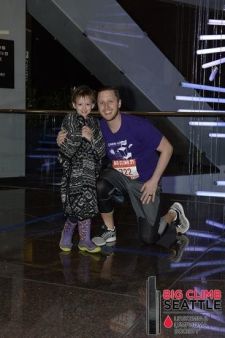
Curran Parker - Climbing For Curry
When Curran Parker, the namesake of team Climbing for Curry, was diagnosed with Hodgkin's lymphoma at the age of 20, doctors told him his first treatment had a 90% chance of successfully eliminating his cancer. As it turned out, Parker ended up in that remaining 10% with his cancer returning only three months later in a mass four times the size as before.
Parker's young-adult world and "immortal" sense of self was undoubtedly shaken. But this wasn't his first or last medical scare, as he had been previously diagnosed with focal nodular hyperplasia, meaning reoccurring benign tumors were prone to pop up in his liver over the years. Because of this complication, Parker essentially spent a year in and out of the hospital receiving chemotherapy and radiation, and carefully monitoring if masses on his scans were a result of something more sinister. Despite the tumors' typically harmless nature, every time one would appear it would impart a sense of fear that his lymphoma had made a comeback.
Parker says one of the masses was found in his chest and gave his oncologist cause for concern. But he finds great satisfaction in that on his doctor's very last day as a practicing oncologist, they were lucky enough to find the mass had mysteriously regressed and disappeared entirely on its own. As Parker puts it, he was free.
Now 27 years old and past his 6 year remission mark, he is officially considered in the clear. At this point he is adamant he's in remission for the long haul and fully intends to live his life accordingly.
"Throughout my entire time in remission I felt like something was telling me that it was going to be ok," Parker said. "[I knew] there would be trials and challenges but once I was cured, I was cured."
Since then he has finished his degree in Business Administration from Northwest University and even got married in September 2016. He sees a life spent fixating on something he believes will never come back is senseless and therefore he fully intends to live his days without fear. It's obvious the nurturing care and support he received while going through treatment has left Parker with an attitude that is hard to break.
"I think its taken my perspective to go from worrying about everything to just knowing that ultimately we don’t have the control that we think we do," Parker said. "Pertaining to family, it's given me a stronger backbone to have gone through something like this. To love people better, love my wife better, and care for people in a way that I don’t think would’ve been possible if I hadn’t been cared for during that time."
His inspiration to keep raising funds to find a cure for blood cancers doesn't just come from his own experience. During the 2016 Big Climb, Parker was introduced to a little girl named Olivia who was battling her own form of blood cancer, and was there to support his team. She was sporting a shirt that read "Olivia & Curry", and Parker admits that although he isn't easily shaken, spending time with Olivia that day absolutely melted his heart in a way he'll never forget. Thinking of a child like Olivia going through treatment and the pain of cancer when her life has barely started absolutely "wrecked" him.
"She's the reason why I climb," Parker said.
Whether it's a patient like Olivia, the immense financial burdens many patients have to overcome, or frustrations with his own experience fighting cancer as a young adult, Parker is passionate about raising funds to find a cure.
"I went through a year long battle with multiple failed treatments and was supposed to die," Parker said. "I went through that entire battle and came out the other side and still for the next 5 years had to face all these different scares and prognoses. Most people don't just get cancer and then they're healed and it's done, most people have to go through it multiple times. So imagine going through he worst hell possible, and having to pay bills for thousands and thousands of dollars just to live, then having to do it again. That's the world we live in right now and it's really, really sad."
Although he admits the physical side of the climb can be a nightmare, it's what the Big Climb represents and the funds it raises that keeps Parker coming back every year.
"It's an event where a lot of love happens in a very small space, or rather, in a very small stairwell," Parker said. "It's an opportunity for people who aren’t really that affected by health problems to pay it forward and to be a blessing on somebody’s life."
He hopes that over the years Climbing for Curry, which was started by one of his sisters in 2011 in his honor, will continue to grow exponentially in greatness. For a team that hit the $100,000 fundraising milestone in 2017 after only five years climbing, there's no doubt that they'll continue to achieve that goal.
For him, sharing his blood cancer story means giving back to the community. It's important to be a part of something bigger than himself, and if he can help one person along the way by sharing his experiences and lessons learned, that's really all he can ask for.
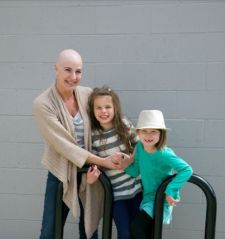
Dawnelle DeMarco - Team Soulumination
Puget Sound native, Dawnelle DeMarco, wears many hats. She is a 44-year-old mother of two, works multiple jobs including being in the middle of an, "illustrious taco career," is a powerhouse fundraiser for the Leukemia & Lymphoma Society and is a blood cancer survivor.
For the past eight years, DeMarco has been slinging kalua pork goodness on the Seattle food truck, Marination. She’s a self-described “taco angel” and has never loved a job more. This busy mother also finds time to work Marination catering events, pick up shifts at the Hawaiian/Asian fusion restaurant Super Six, has gigs with Guinness Beer, and still raises thousands of dollars for LLS's Big Climb Seattle every year.
One might think that with an already jam-packed schedule, being handed a cancer diagnosis on top of an already existing autoimmune disease might break a person's spirit. But DeMarco is undeniably tenacious, driven and ultimately optimistic. She's the kind of person that likes to have a party wherever she goes, and lives her life accordingly.
It was on March 25th, 2014, when DeMarco was diagnosed with stage 4 diffused large B-cell lymphoma. She had noticed that her face looked swollen in a photograph back in October 2013 and was in turn prescribed some steroids by her physician. After the swelling went down she noticed a lump appear in her neck which was eventually biopsied.
When she returned to the doctor expecting to hear that the lump simply needed to be removed, she felt her stomach drop as soon as the doctor opened his mouth. She could tell he was about to inform her that she had cancer.
Cancer wasn't the first disease DeMarco was diagnosed with. She suffers from Sjögren's Syndrome, an autoimmune disease that affects about 1% of the population. This disease essentially causes extreme dryness of exocrine (salivary) glands, most commonly affecting a person's mouth.
What DeMarco didn't know when she was diagnosed with Sjogren's Syndrome, was that it increases a person's risk for getting this specific type of lymphoma. It wasn't til later down the line that she discovered this inherent risk, and says it was no doubt unsettling that one disease she thought was manageable spurred on something more dangerous.
She was first told that due to lack of general symptoms, her cancer was likely stage 1 or 2. But after a PET scan that soon followed, DeMarco's doctor revealed the frightening truth that her cancer was "everywhere."
“It was found in my abdomen, pelvis, arm pits and lungs,” DeMarco said. “I started chemo a week later. It was the scariest moment finding out that I went from stage 1 to stage 4 and I really thought I was going to die.”
She then began treatment, and underwent six rounds of R-CHOP therapy.
For her first round DeMarco brought many of her friends along to the hospital. Before her dose was administered, the group broke out in dance to the song Happy by Pharrell Williams, not because she necessarily needed the encouragement, but because she didn’t want her friends and family to feel like she wouldn’t be able to handle it. She knew she could, but it's no doubt her support network helped.
“I felt people’s love from everywhere and I think that really saved me,” DeMarco said.
Like with many cancer patients' experiences, treatment doesn't always go perfectly smooth. At one point, she had an allergic reaction to the medicine Rituxan which left her in the hospital for six days due to a neutropenic fever.
On top of that, because of her autoimmune disease DeMarco's mouth got very infected which she says was intensely painful and left her unable to eat anything for five days.
When her hair began to fall out exactly two weeks after her first chemo treatment, she was alarmed by how painful of an experience that proved to be. No one had warned her that losing hair as a cancer patient would hurt, which only added insult to injury as she watched her long hair fall away. She soon shaved the rest of her hair off and was completely bald by her second round of chemo.
DeMarco says because she didn't often outwardly appear sick, many people asked her who she shaved her head in honor of. It was as if no one could believe she was in fact the cancer patient they were inquiring about.
Since then, DeMarco has made leaps and strides in her treatment and recovery, and recently passed her three year remission mark on July 25th, 2017.
“It feel amazing," DeMarco said. "Sometimes I think it’s hard to believe that I really had cancer. It seems like it was both yesterday and a million years ago.”
But just because this diagnosis seems like the distant past, she is hyperaware of how cancer is constantly burdening the lives of many others, including her dear friend and fellow Big Climber, Lynette Johnson.
The two met over 20 years ago when Johnson was photographing a wedding of DeMarco’s childhood friend. After hitting it off at the wedding, DeMarco knew she had to have Johnson photograph her own wedding a few years later, and ever since the two have become closer than they ever would have ever imagined.
“We both have two daughters, both had two miscarriages, and other weird, random things that have happened to us after growing and knowing each other for so many years,” DeMarco said. “We then became bald women at the same time.”
Both women are member of the Big Climb team, Team Soulumination, and members of the Elite 30, a group of the top 30 individual fundraisers from the previous year's event. Last year alone, DeMarco raised a stunning $7,445 for blood cancer research and patient access services, and says she's set her sights on hitting the $10K mark in coming years. With over 1,500 friends on Facebook, she is confident that if everyone donated just a little, she could surpass her goals.
"Every year I don’t want to ask people for money, but then I see Lynette and I know this is why we do it, and then I don’t feel bad because there has to be a change in how people in are treated," Lynette said. "Chemo doesn't work for everyone and its basically killing us anyways, there have to be better ways."
Whether you're an Elite 30 fundraiser or just climbing for the very first time, DeMarco knows that Big Climb is an opportunity like no other.
"This is one small way one can actually make a difference in the world," DeMarco said. "I truly believe that."
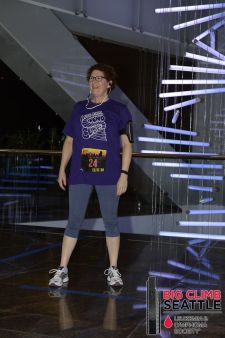
Larissa Dhanani - Larissa' Crew
Back in 2008, Blaine, WA resident Larissa Dhanani received some bruises while playing a casual game of tennis. The bruises were largely shaped, strangely firm in the center, darker than average, and refused to fade away. As a typically healthy person she suspected her iron levels must've been low, so she made an appointment with her doctor in Bellingham.
It was shockingly revealed that her white blood count was off the charts, and she was quickly diagnosed with Chronic Myeloid Leukemia (CML) at the age of 55.
It wasn't her doctor or an empathetic nurse that delivered the news. She simply received a phone call, likely from a lab tech who processed her blood results. He began rattling off numbers and complex terms in a way that made Dhanani feel like whatever it was he was telling her she had, she was going to die from it. The very next day she was admitted into the hospital.
It was found that her CML was positive for the Philadelphia Chromosome. This meant due to translocation of part of chromosome 9 with chromosome 22, the latter is left abnormally short and causes a protein to signal for uncontrolled division of cancerous cells. This chromosomal defect is present in about 85% of CML patients. Luckily, doctors told her they had the “perfect” LLS-funded drug called Imatinib, (Gleevec) which she was put on right away. It only took three months for her white blood cell count to stabilize.
But this wasn't the end of her cancer journey. Dhanani eventually became resistant to Imatinib and had to be relocated over 100 miles south to be further treated at the Seattle Cancer Care Alliance where she stayed for over seven months.
In Seattle she was switched to another drug called dasatinib (Sprycel). As a common precautionary procedure in case she did not show success with this second chemo drug, her oncologist tissue matched Dhanani’s family members to see if any of them could be a match for a bone marrow transplant. Thankfully it turned out her brother, Doug, was indeed that person.
Dasatinib only worked until December 2010 for about 1.5 years until she received another blood test with concerning results. Her cancer had come back in early 2011 and was in what her doctor called "blast crisis." She had tested 95% for AML – meaning her leukemia had come back as acute, with higher potential to spread more quickly and a higher risk for death.
"It felt as if my doctor was saying goodbye to me, and like he didn't know what there was to do," Dhanani said.
But despite this turn of events, there was a treatment plan put in place. She was placed on "bookend" chemo with a third drug, nilotinib (Tasigna). She received treatment, then given rest for a week, and then back on chemo in order to outsmart her quickly-adapting leukemia cells. In order to officially be accepted as viable bone marrow transplant candidate, her leukemia cell count had to be down to zero, which by no means is easy to achieve.
Dhanani says this three month period prepping for her transplant was the most difficult. The new form of chemo she endured was so toxic that any clothes she had been wearing needed to be washed before she was allowed to wear them again. Her hair began to fall out, she felt ill all of the time, had gastrointestinal distress, insomnia, intense heartburn, and such severe skin sensitivity that she couldn't even open the fridge door because the cold air was too much of a painful shock. To top it off, she even had to miss her youngest son’s senior year of high school while in the hospital.
Throughout this process she had to return to the hospital for regular lumbar punctures to insert chemo into her spinal fluid, and says she feels lucky that she didn't experience any complications with these procedures. When it came to radiation, Dhanani wasn't about to back down.
"Doctors told me I could get a certain amount divided over ten days, or could take the maximum amount instead, to which I said, ' I guess I'll go big!'" she said.
In order to kill off her immune system so her body would be able to tolerate a foreign transplant, she endured 14 rounds of radiation in one week. She stood alone in a room locked in by a massive metal door. There was a stool behind her, but doctors told Dhanani to only use it in case she thought she was going to faint. The Where's Waldo poster hung on the wall opposite the chair meant to keep patients distracted wasn't of any use to her, since without her glasses she couldn't see. She admits with a laugh that she wasn't very good at that game.
But her three sons, now aged 23, 26 and 30, would come every day to be with her during her radiation appointments, whom the nurses started affectionately referring to as her security guards. Her sons made her a "radiation CD" to listen to while under treatment so she wouldn't have to be alone with her thoughts.
Dhanani's middle son even decided to drop out of college for a quarter to move to Seattle, take a caregiver's course and be there for his mom when his dad had to be back in Bellingham running his business.
After radiation she was given a day to rest, and then it was time for the transplant. She was in the hospital for 20 straight days, and was only allowed to leave when she could show she was able to eat solid food, stand up on her own, and prove she had 24/7 care from friends or family.
Currently, Dhanani is in remission. However, while she has passed the 5 year remission mark, her doctors don't consider her cured. They tell her they simply don't know enough about if the Philadelphia chromosome is truly gone post-transplant, so they cannot definitively declare her cancer free. She's 6 years out now, and doctors say the further she gets the better chance she has at no relapse.
Although things are quite concrete, she keeps a positive attitude.
"I just try to be involved in my life," Dhanani said. "If I get a little too inside my head I make sure to get out and go do something."
Whether it’s taking Zumba classes like a fiend, or climbing 69 flights of stairs for Big Climb, Dhanani is staying active and motivated for her future.
It was back in 2011 when her youngest brother first heard of the Big Climb and decided to climb solo but under the name Larissa’s Crew. That year he individually raised an impressive $13,000 in her honor. Though she still can’t believe it, that following year she was able to participate on Larissa’s Crew and complete her first climb. In the span of just 6 years, her Crew has raised over $200,000 and Dhanani couldn’t be more motivated.
"The fundraising is what saved my life," she said.
For her it really is all about the research. "These [researchers] who love their job doing meticulous research, they're the reason I got to get to my 50th birthday, to see my kids get married, and see my grandkids," Dhanani said. "They told me if I had this diagnosis 10 years previously it probably would've been a death sentence. This research is everything.
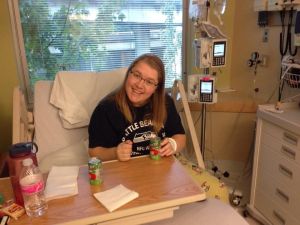
Ruth Ramsey - Sassy Steppers
Ruth Ramsey, team captain for Big Climb Seattle's Sassy Steppers, has been through more medical scares in her life than most. Yet, her attitude is unwavering.
It all began back in 2008 after Ramsey found herself experiencing headaches for six months straight. Her doctors found a brain tumor which they initially thought was brain cancer and told her she might only have six months to live.
After undergoing brain surgery to have the tumor removed, it was discovered that the tumor was actually benign. But in turn, Ramsey was diagnosed with a hereditary disease called Von Hippel-Lindau (VHL). VHL results in the occurrence of typically benign tumors in various parts of the body (often around the kidneys), although it is rare for growth of this sort to begin in the brain.
From there on out, Ramsey must go in for annual MRIs to monitor if any new tumors have arisen, and to catch any in case they have the potential to become malignant. During one of these scans in 2013, Ramsey's radiologist found cause for concern when they noticed an abnormality far from the kidneys, located in her abdomen. After a needle biopsy through her back, Ramsey received her second disease diagnosis. This time it was follicular lymphoma.
At the time she felt completely healthy. She had no problematic symptoms, so her health was monitored with regular blood draws conducted at the Seattle Cancer Care Alliance (SCCA). It wasn't until a year later in August of 2014 when Ramsey woke up to a lump on her neck that was getting bigger as each hour passed that had to begin treatment.
Upon returning to the SCCA, her method of chemotherapy was determined and was set to be relatively mild. After her first treatment, it only took about 15 minutes for her cancerous lump to become invisible in size. After this, she went in for infusions every Wednesday and Thursday, every four weeks, for six rounds. Then she was put on two years of maintenance therapy and is relieved to say that she recently finished her treatment in January 2017.
However, although she isn't currently on medication, doctors say that her cancer is 100% certain to come back. They say it'll likely lay in remission for around 2-3 years before she'll have to start up chemo once more.
"It just sucks and there isn't really another way to put it," Ramsey said. "But at the same time at the end of the day I'm thankful it was found the way it was, that my body reacted well to the treatments I got, that I didn’t' lose my hair, was able to keep my job, and I know that it could've been much, much worse."
It is indeed true that it hasn't all been negative over the past 10 years during this battle. In 2011, she got married to her husband, whom she says has been at her side for every single step of the way. They met in 2007, only one year before she had brain surgery and she jokes that at this point, he knows what's going on with her body far more than his own. He likes to (lovingly) say she should’ve come with a warranty.
Their family expanded in 2007 when they adopted a greyhound, who Ramsey soon got certified as a therapy dog after she spent time in the hospital for her brain surgery. For a while, Ramsey took her dog for volunteer trips at Camp Corey in Carnation, WA, to spend time with children who had a variety of medical issues, and expose them to the gentle love of a dog they might not otherwise get to meet.
"I felt like it was my little token of giving back to the world," Ramsey said.
Although they now have two greyhounds, having children is out of the cards for Ramsey and her husband. Because she has a 50/50 chance of passing on VHL to any offspring, the risk just runs too high. That, and her body is busy enough already battling a cancer that is sure to come back.
But that doesn't mean Ramsey is never around children, as she is a career math teacher who now works in the Issaquah School district. As a math teach at Skyline High School in Sammamish, WA, Ramsey has enjoyed teaching for the past 18 years, 10 of which she has spent at Skyline, and eight on Mercer Island where she grew up.
Whether she's teaching kids Algebra I equations or complex formulas in IB Math, Ramsey values making a difference in the lives of her students.
"My students don't have to love coming to class, they don’t even necessarily have to like it, but my goal is for them to not hate coming," Ramsey said. "I love it when a kid thinks they can't do something and then they discover that they actually can."
Her students and fellow faculty were incredibly understanding and supportive, and for that she is grateful.
"The average age of diagnosis for the type of cancer I have is 62," Ramsey said. "I was diagnosed at the age of 37 so if I follow the trend of reoccurrence then I'm going to end up getting more chemo than other people. I know I could lose this battle, but I'm thankful that I can go to work on Monday even if I'm not at my best, because at least I'm still there."
Ramsey, now 41 years old, is a straight shooter to the core. When she was first diagnosed it was common for people to ask her how she could be so positive about her situation. She simply explains that there wasn’t much else to do than deal with her situation day by day, and not waste her time or energy being upset about something she couldn't control.
"Life doesn't stop because you have cancer," Ramsey said. "It just keeps happening. And I've learned that I'm stronger than I ever thought I was, and that I can handle a lot of terrible things that get thrown my way. But I've made it here, I've done all that, so I can take on the world. Bring it on.”
Currently, she goes in every three months for a check-up appointment with a blood draw, and still feels grateful that if it hadn't been for her VHL, she would've never been getting those preventative scans in the first place that ended up identifying her cancer early on. And this grateful and humble nature is the attitude that Ramsey seems to take with everything in her life.
"It could be so much worse, and it's just too much effort to let things get to me, so why bother?" Ramsey says with a laugh. "Tomorrow will come regardless of how I feel, it'll still take the same amount of time so I'll do what's necessary and that's it."
There is one exception for Ramsey looking toward the future, and that comes with finding a cure for blood cancers.
“I'm forever grateful that there's an organization like LLS to fund and support amazing breakthroughs,” Ramsey said.
She's been participating in the Big Climb since 2014 when her friend wanted to climb in honor of her sister who had been diagnosed with a form of leukemia. Now they're hooked, and Sassy Steppers not only returns every year but keeps on growing in size.
It's obvious that she isn't an emotional person, but on climb day there is an inherent emotional energy that permeates the mood. For her, it's not just about the money or the event itself, it's about the camaraderie of doing something powerful and amazing together. When it comes to recruiting people to join the team, Ramsey admits that she has some selfish reasons.
“I want people to do this for me," Ramsey said. "And of course, that will benefit other people too, but right now I will do chemo for the rest of my life and it sucks, no one is going to pretend otherwise and there needs to be a cure. Secondly, I want people to it for themselves because as much as they think they can't do this, they totally can and I guarantee when they finally make it to the top [of the Columbia Center] that they'll be amazed at what they've accomplished."
She’s passionate about the fact that no one should have any hesitations for why they can't climb, and says that during her second year she climbed only 17 days after a chemo treatment, so she won't listen to any excuses.
"Anything that can be done to help people like me who will have it for the rest of their lives is valuable. And if it means climbing a few stairs then ok, lets climb those stairs, because it means I can help find a cure."
